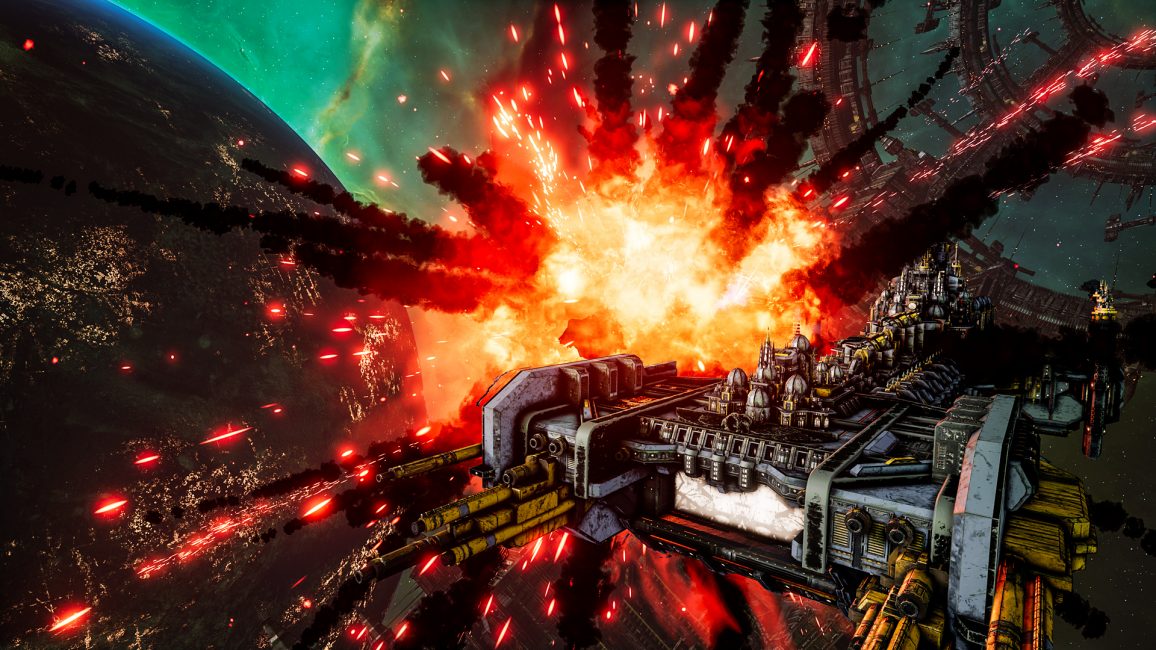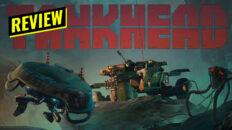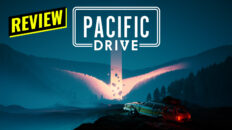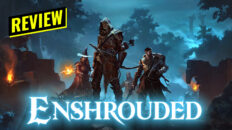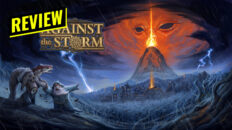Developer: Tindalos Interactive
Publisher: Focus Home Interactive
Reviewed on: PC
Code Received.
Battlefleet Gothic Armada II is a real-time strategy game set in the Warhammer 40,000 universe. In it you assume control of a small fleet of space-faring war ships and wage naval combat against your foes. It contains three fairly lengthy campaigns that can be played alone or in online co-op. It also features a competitive multiplayer/skirmish mode. On the surface it’s a competent real-time combat simulation that unfortunately lacks the depth necessary to keep things interesting. Combine that with some severe stability issues and bugs, and it becomes very hard to recommend.
I spent most of my time running through the three campaigns that are on offer. Each one follows a different faction as they vie for galactic superiority. The first campaign has you taking control of Admiral Spire, who fights for the Imperium of Man. The story has you arriving shortly after the destruction of the planet Cadia at the hands of a Chaos fleet, and is typical Warhammer material. I couldn’t keep track of how many times Admiral Spire said “For the Emperor” in a solemn, emotionless tone as if it was their version of “over-and-out”. But this what the Imperium is and what makes this universe so charming. The player knows their blind faith in the Emperor is flawed and misguided, yet you have to see it through non-the-less. Eventually the story spirals into predictability, with new even more terrible events unfolding at every turn. The other campaigns have you taking control Tyrandis and Necron fleets, offering different perspectives and play styles.
I actually found the campaigns to be engaging, at least at first. They are broken up into two distinct parts: The turn-based campaign map and the real-time combat engagements. On the map you move your fleets between planetary systems in order to capture them and the benefits they offer. If an enemy fleet occupies the system you must destroy it in order to take control of the system. It’s all based on the power level of each fleet, so if your power level is higher than your enemy’s then you should be able to take them out. You can either choose to take manual control of the battle, which then launches the previously mentioned real-time combat engagement, or you can auto-resolve. Auto-resolving obviously saves time, but should only be used if you vastly outnumber your foe. The flow reminded me of the Total War games. The turn-based map screen isn’t as in depth as those games, but the balance between the strategic turn-based moments and the tactical real-time combat was satisfying.

You also earn renown for winning battles and completing missions, which is basically experience points. You can use those points to unlock upgrades on a pretty simple skill tree. Things like stronger shields, faster ship repair, and more ammo make up most of the upgrades. You also get passive bonuses from certain systems you capture that can be upgraded. These include things like advanced ship yards to make better ships and planets to earn more money or renown. You’re constantly balancing your meager funds between bolstering your fleet or upgrading planets. At first this seemed like a fun layer of micromanagement, but eventually it just turned into tedium. There’s no way to afford all the upgrades in each system so when you have a small amount of money to spare you spend too much time clicking on a dozen little exclamation points trying to find that perfect upgrade. There just isn’t enough strategy going on here to justify the time needed to maximize efficiency.
The other downside of the campaign are the “event” missions. While you spend most of your time taking out small fleets and capturing systems, it’s always in service of your next main objective. Every turn you take without completing an objective results in the game’s threat meter going up. If it gets too high a huge enemy fleet will spawn that you have to deal with. This limits the strategic options on the map screen even further by forcing you to rush to your next objective, not taking the time to really plot out the best course of action. On top of that, some of the main missions don’t tell you what the enemy’s strength will be before you start, so you’re essentially going in blind. This leads to a lot of trial and error, a lot of save scumming (which the game almost suggests you do), and a lot of wasted time. Battles can sometimes go on for 30 minutes or more, and if you get down to your last ship only to find out you just don’t have the man power to pull it off, it can be very frustrating.

Once actually in combat the game gets a little more interesting. You move your ships around the play area and take advantage of some of the natural terrain. There are gas clouds that can conceal your ships and asteroid fields that can cut line of sight and weapons fire. There can also be random occurrences like large floating creatures that explode when hit with weapons fire causing massive damage to ships caught in the blast or solar flares what sweet across the play zone, disabling shields. These things add some flavor to each fight, but it isn’t enough to escape the repetitive slog that most of the battles become. There’s no ship customization, so you pretty much have the same ships throughout the whole campaign. That limits experimentation and means most of the fights play out the same every time. Generally speaking, you want to send your largest ships in first and have them engage the enemy fleet from medium range. Then use your smaller, faster ships to pick things off from a distance. A lot of this is automated, just press a button and your cruisers will circle the enemy, firing automatically. Each ship does offer special skills, which is where things can and sometimes do get interesting.
Once you get close enough you can preform boarding actions, which in practice function just like normal weapons fire. You can also have ships that have hanger bays for small strike craft and bombs for added damage and special effects. I felt like I had a solid grasp of these concepts coming out of the short tutorial and was disappointed to find out that there wasn’t much variety to see past that. The other factions do offer ways to mix things up, like the Tyrandis ships can make quick jumps to get out of hairy situations, but just like the other abilities the novelty wears off quickly. I will say that some of the best moments in the game are when you take control of special ships or have to handle a unique scenario. In one instance I was in control a massive floating space worm that was capable of wiping out huge fleets by itself. It was a fun way to mix things up, but as soon as it was over it was back to business as usual. There is certainly a high level of strategy that can be yanked out of these systems, and I saw it once in a while in the multiplayer. It’s just, overall, I never felt compelled to engage with it most of the time.

Not only are the game’s own systems playing against you, but so is its stability. During review I had the game crash many times on two different systems. Sometimes it would be at the start of a battle, other times it would be mid battle. When you’re 15 minutes into a 30 minute battle and the game crashes it can be pretty disheartening. There are also no mid-battle saves so you are forced to start all over. I also ran into an issue where the mouse cursor would randomly disappear from time to time. Finally, I had two instances of an enemy ship that glitched out and refused to take any damage, effectively making the mission impossible to complete. These issues on top of a game that’s already hard to recommend even when it works makes this an even more dire situation.
The multiplayer and skirmish mode works well. I was able to match with other players just fine and the matches seemed stable. I am terrible when it comes to online strategy games, so I didn’t spend too much time here, but what I saw was solid. You can choose your faction, fleet, and some starting upgrades. You can also set up matches against the AI here as well. It seems like a good place to go if all you want are some quick space battles and don’t want to deal with the campaign map business. It’s also where you’ll encounter the most challenge.
It’s really disappointing to see Battefleet Gothic Armada II bogged down by it’s own weight. If a little more care went into the campaign map’s strategic layer or if the combat allowed for more customization it would have been a much more interesting game. And for some these things probably won’t be deal breakers. However, when you factor in the numerous stability issues and bugs it’s really hard to recommend. Battefleet Gothic Armada II is a pretty apt comparison to the current Warhammer video game-space. It has some high highs, some really low lows, and even when it lands somewhere in middle it’s rarely worth your time.
[full_width]PC Specs:
Windows 10 Pro 64-bit
Intel Core i7-4790K 4.0GHz
16GB RAM
GeForce GTX 980 Ti 6GB VRAM
Samsung EVO 850 SSD[/full_width]


